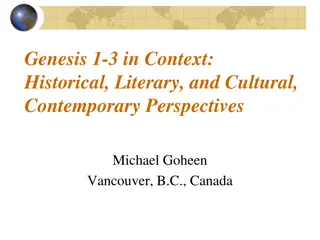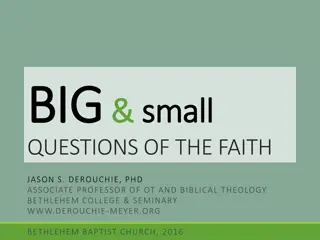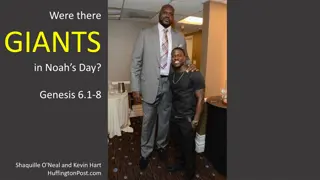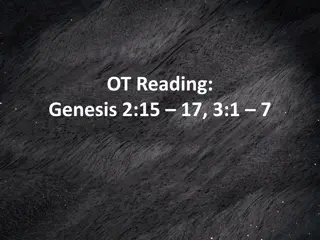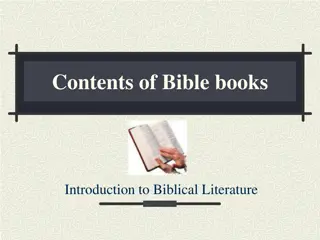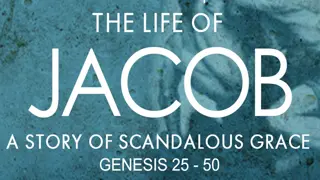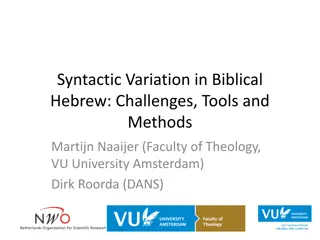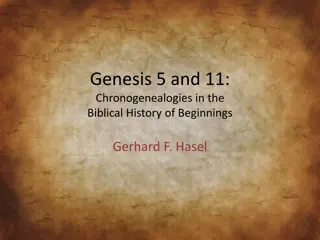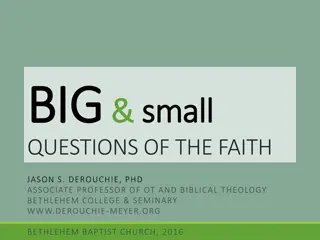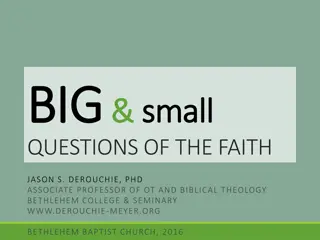The Biblical Account of Origins: A Critical Analysis of Genesis 1:1
The study examines the pivotal verse Genesis 1:1, exploring the implications of different translations and interpretations regarding the absolute or relative beginning of creation. The analysis delves into the theological and philosophical implications of the text, shedding light on the nuanced perspectives of creation ex nihilo and the nature of God’s existence pre-matter.
Download Presentation

Please find below an Image/Link to download the presentation.
The content on the website is provided AS IS for your information and personal use only. It may not be sold, licensed, or shared on other websites without obtaining consent from the author. Download presentation by click this link. If you encounter any issues during the download, it is possible that the publisher has removed the file from their server.
E N D
Presentation Transcript
THE BIBLICAL ACCOUNT OF ORIGINS JOURNAL OF THE ADVENTIST THEOLOGICAL SOCIETY 14/1 (SPRING 2003) 4-43 By Richard M. Davidson
BASIC ELEMENTS IN THE BIBLICAL ACCOUNT In the beginning the when of origins God the Who of origins created the how of origins the heavens and the earth the what of origins
WHEN WHO HOW WHAT
WHEN WHO HOW WHAT Absolute or Relative Beginning?
TWO MAJOR TRANSLATIONS WHEN--Absolute or Relative Beginning?
TWO MAJOR TRANSLATIONS Independent Clause Dependent Clause WHEN--Absolute or Relative Beginning?
TWO MAJOR TRANSLATIONS Independent Clause Dependent Clause In the beginning God created the heavens and the earth. KJV, NIV, NJB, NLT, NASB, NKJV, REB, RSV WHEN--Absolute or Relative Beginning?
TWO MAJOR TRANSLATIONS Independent Clause Dependent Clause In the beginning God created the heavens and the earth. When God began to create the heavens and the earth . KJV, NIV, NJB, NLT, NASB, NKJV, REB, RSV NJPS , NAB, NRSV, NEB WHEN--Absolute or Relative Beginning?
TWO MAJOR TRANSLATIONS Independent Clause Dependent Clause No creatio ex nihilo is mentioned. Matter is already in existence when God begins to create. The heavens, earth, darkness, the deep, and water already exist at the beginning of God s creative activity. No absolute beginning is indicated. Creatio ex nihilo is explicitly affirmed. God exists before matter. God creates the heavens, earth, darkness, the deep, and water. There is an absolute beginning of time for the cosmos. WHEN--Absolute or Relative Beginning?
IMPORTANCE The issue between these two options is not esoteric quibbling does Genesis 1:1 suggest that in the beginning there was one God; or does it suggest that in the beginning there were two God and preexistent chaos? Victor P. Hamilton, The Book of Genesis: Chapters 1-17 WHEN--Absolute or Relative Beginning?
EVIDENCE FOR INDEPENDENT CLAUSE According to Hebrew grammar and syntax, the natural reading of Genesis 1:1 is as an independent clause: In the beginning, God created the heavens and the earth. WHEN--Absolute or Relative Beginning?
EVIDENCE FOR INDEPENDENT CLAUSE The short, stylistic structure matches the rest of the chapter. WHEN--Absolute or Relative Beginning?
EVIDENCE FOR INDEPENDENT CLAUSE The theological thrust of a God who transcends matter matches the rest of the chapter. WHEN--Absolute or Relative Beginning?
EVIDENCE FOR INDEPENDENT CLAUSE All the ancient versions (LXX, Vulgate, etc.) use the independent clause. WHEN--Absolute or Relative Beginning?
EVIDENCE FOR INDEPENDENT CLAUSE John 1:1 alludes to Genesis 1:1 and uses the independent clause. In the beginning was the word WHEN--Absolute or Relative Beginning?
CONCLUSIONABSOLUTE BEGINNING I find the weight of evidence within Scripture decisive in pointing toward the traditional translation of Genesis 1:1 as an independent clause: In the beginning God created the heavens and the earth. WHEN--Absolute or Relative Beginning?
WHEN WHO HOW WHAT Literal or Non-Literal Beginning?
IMPORTANCE Without a literal beginning, there is no literal end. The doctrines of humanity, sin, salvation, judgment, Sabbath, etc., presented already in the opening chapters of Genesis, all hinge upon a literal interpretation of origins. WHEN Literal or Non-Literal Beginning?
EVIDENCE FOR LITERAL BEGINNING Literary genre of Genesis 1-11 points to the literal historical nature of the creation account. Best genre designation is historical narrative prose The narratives of Genesis 1-2 lack any clues that they are to be taken as non-literal The creation narratives are different than later biblical narratives, but this is because of their subject matter (creation) and not their literary form (narrative) WHEN Literal or Non-Literal Beginning?
EVIDENCE FOR LITERAL BEGINNING The literary structure of Genesis as a whole indicates the intended literal nature of the creation narratives Genesis structured by the word generations Used in the setting of genealogies concerned with the accurate account of time and history These are the generations of the heavens and of the earth shows the author intends it to be literal WHEN Literal or Non-Literal Beginning?
EVIDENCE FOR LITERAL BEGINNING The use of specific temporal terms Evening and morning at the conclusion of each of the six days of creation Use of evening and morning together outside of Genesis 1, invariably, without exception in the OT (57 times) indicate a literal solar day WHEN Literal or Non-Literal Beginning?
EVIDENCE FOR LITERAL BEGINNING The use of specific temporal terms The occurrence of the Hebrew word for day (yom) with ordinal numbers (first day, second day, third day, etc.) elsewhere in Scripture reveals that such usage always refers to literal days References to the function of the sun and moon for signs, seasons, days, and years indicates literal time WHEN Literal or Non-Literal Beginning?
EVIDENCE FOR LITERAL BEGINNING The divine Lawgiver unequivocally interprets the first week as a literal week, consisting of seven consecutive, contiguous twenty-four-hour days. Remember the Sabbath day to keep it holy six days shalt thou labor but the seventh day is the Sabbath for in six days the Lord made heaven and earth, the sea, and all that in them is Exodus 20:8-11 WHEN Literal or Non-Literal Beginning?
EVIDENCE FOR LITERAL BEGINNING Jesus refers to Genesis 1-11 with the underlying assumption that it is literal, reliable history Jesus refers to Genesis 1, 2, 3, 4, 5, 6, and 7 WHEN Literal or Non-Literal Beginning?
EVIDENCE FOR LITERAL BEGINNING The biblical writers understood the six days of creation as six literal, historical, contiguous, creative, natural twenty- four-days. All NT writers refer to Genesis 1-11 with the underlying assumption that it is literal, reliable history Every chapter of Genesis 1-11 is referred to somewhere in the NT WHEN Literal or Non-Literal Beginning?
EVIDENCE FOR LITERAL BEGINNING The author of Genesis 1 could not have produced more comprehensive and all-inclusive ways to express the idea of a literal day than the one chosen. (Hasel, The Days of Creation in Genesis 1 ) WHEN Literal or Non-Literal Beginning?
CONCLUSIONLITERAL Based upon the testimony of the Genesis account and later intertextual allusions to this account, I must join the host of scholars, ancient and modern both critical and evangelical who affirm the literal, historical nature of Genesis 1 and 2, with a literal creation week consisting of six historical, contiguous, creative, natural twenty-four-hour days, followed immediately by a literal twenty-four-hour seventh day, during which God rested, blessing and sanctifying the Sabbath as a memorial of creation. WHEN Literal or Non-Literal Beginning?
Even critical scholars protest non-literal interpretations WHEN Literal or Non-Literal Beginning?
LITERAL so far as I know there is no professor of Hebrew or Old Testament at any world-class university who does not believe that the writer(s) of Genesis 1-11 intended to convey to their readers the idea that creation took place in a series of six days which were the same as the days of 24 hours we now experience James Barr, critical scholar WHEN Literal or Non-Literal Beginning?
LITERAL Everything that is said here [in Genesis 1] is to be accepted exactly as it is written; nothing is to be interpreted symbolically or metaphorically. Gerhard von Rad, critical scholar WHEN Literal or Non-Literal Beginning?
It is not the text that causes people to think otherwise, only the demands of trying to harmonize with modern science.
WHEN WHO HOW WHAT Multiple of Single Beginnings?
ACTIVE GAP THEORY The earth becamewithout form and void Active Gap Theory ruin restoration Satan ruled an originally perfect creation some unknown time ago, before his rebellion Earth became chaotic because of Satan s experimentation God s judgment WHEN Multiple or Single Beginning?
ACTIVE GAP THEORY Theory flounders on grammatical grounds The earth was without form and void Hebrew grammar leaves no room for this interpretation WHEN Multiple or Single Beginning?
INITIAL UNFORMED-UNFILLED VIEW Traditional view, supported by majority of Jewish and Christian interpreters through history God created the heavens and the earth out of nothing at the time of their absolute beginning WHEN Multiple or Single Beginning?
CONCLUSION--INITIAL UNFORMED UNFILLED God is before all creation (v 1) There is an absolute beginning of time (v 1) God creates the heavens and earth (v 1) but (at least) the earth is at first different than now it is unformed and unfilled (v 2) On the first day of the seven-day creation week, God begins to form and fill (v 3ff) The forming and filling creative activity of God is accomplished in six successive, literal, 24-hour days At the end of creation week, the heavens and earth are finally finished (Gen. 2:1) What God began in v 1 is now completed) God rests on the 7th day, blessing and sanctifying it as a memorial of creation (2:1-4) WHEN Multiple or Single Beginning?
WHEN WAS THE ABSOLUTE BEGINNING? No Gap Passive Gap Genesis 1:1-2 are on day one Genesis 1:1-2 go together but are separated from verse 3 by a gap Raw materials are included in the first day of the seven- day creation week Raw materials of the earth in their unformed-unfilled state were created before perhaps long before the seven days of creation week WHEN Multiple or Single Beginning?
EVIDENCE FOR PASSIVE GAP And God said and there was evening and there was morning WHEN Multiple or Single Beginning?
EVIDENCE FOR PASSIVE GAP 1. If the description of the first day is consistent with the other five, this would place verses 1-2 outside of the first day. WHEN Multiple or Single Beginning?
EVIDENCE FOR PASSIVE GAP 1. If the description of the first day is consistent with the other five, this would place verses 1-2 outside of the first day. 2. The dyad heavens and earth (entire universe) are to be distinguished from the triad (heaven, earth, and sea (the three earth habitats). WHEN Multiple or Single Beginning?
EVIDENCE FOR PASSIVE GAP 3. The Hebrew word for beginning in 1:1 does not refer to a point in time, but to a period or duration of time which falls before a series of events. WHEN Multiple or Single Beginning?
EVIDENCE FOR PASSIVE GAP 3. The Hebrew word for beginning in 1:1 does not refer to a point in time, but to a period or duration of time which falls before a series of events. 4. Already in the creation account, there is an emphasis upon God s creating by differentiation or separation involving previously-created materials. WHEN Multiple or Single Beginning?
EVIDENCE FOR PASSIVE GAP 5. The complementary creation account of chapter 2 reveals such a two-stage process of creation. Beginning with the raw materials the clay He formed Adam and breathed into his nostrils the breath of life. God also used a two-stage process to create Eve from the raw material of Adam s rib. WHEN Multiple or Single Beginning?
EITHER OPTION POSSIBLE No Gap Passive Gap Genesis 1:1-2 are on day one Genesis 1:1-2 go together but are separated from verse 3 by a gap Raw materials are included in the first day of the seven- day creation week Raw materials of the earth in their unformed-unfilled state were created before perhaps long before the seven days of creation week WHEN Multiple or Single Beginning?
WHEN WHO HOW WHAT Recent or Remote Beginning? (thousands or millions of years)
EVIDENCE FOR RECENT BEGINNING Genealogies of Genesis 5 and 11 have no parallel among the other genealogies of the Bible or ANE literature. Repeating pattern: A patriarch lived x years, then begat a son; After he begat this son, he lived y more years, and begat more sons and daughters; And all the years of this patriarch were z years. WHEN Recent or Remote?
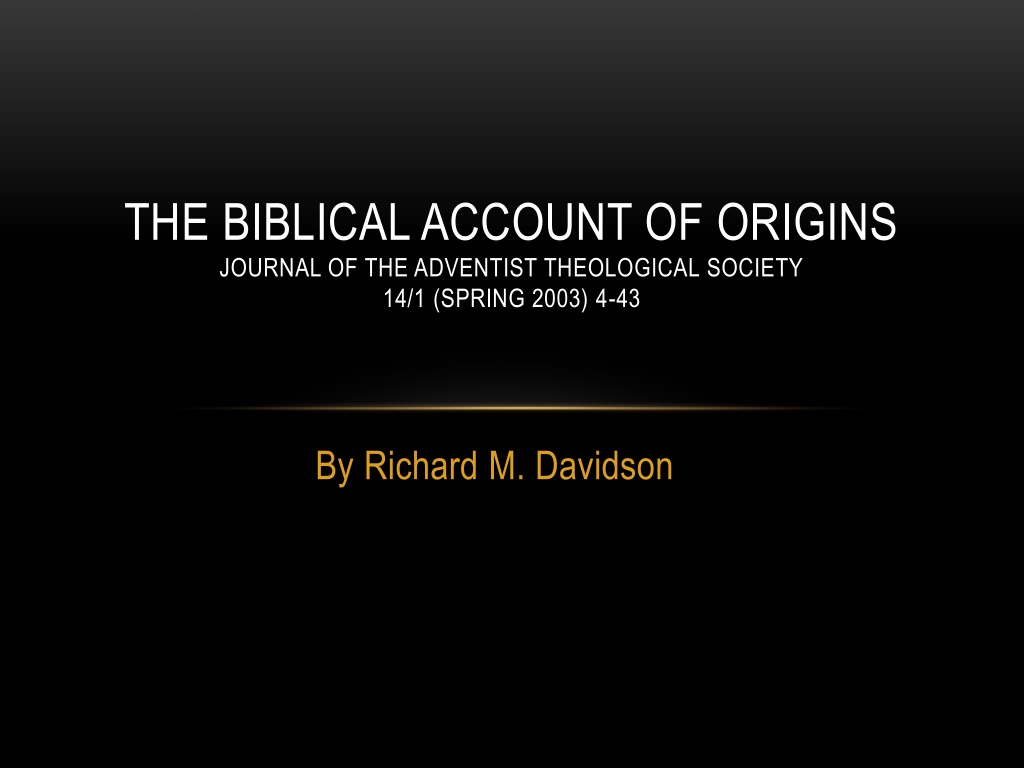
 undefined
undefined





![❤[PDF]⚡ Escaping from Eden: Does Genesis Teach that the Human Race was Created](/thumb/21697/pdf-escaping-from-eden-does-genesis-teach-that-the-human-race-was-created.jpg)
